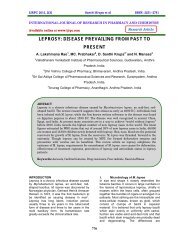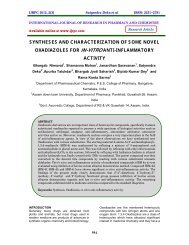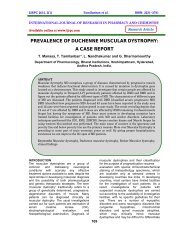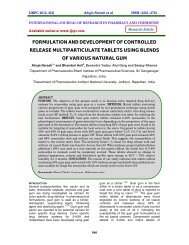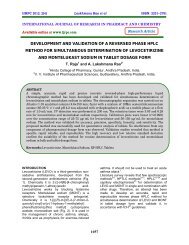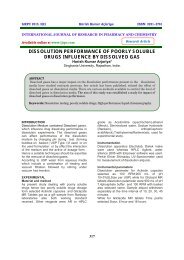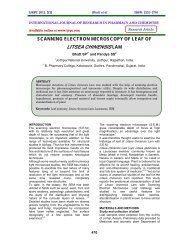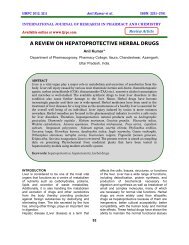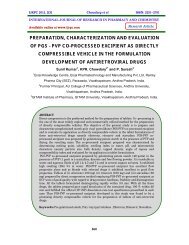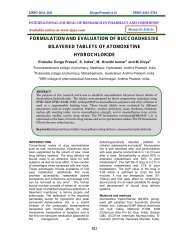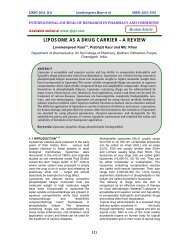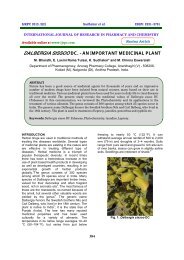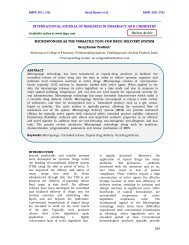evaluation of anti-diabetic activity of leaves of cassia ... - ijrpc
evaluation of anti-diabetic activity of leaves of cassia ... - ijrpc
evaluation of anti-diabetic activity of leaves of cassia ... - ijrpc
Create successful ePaper yourself
Turn your PDF publications into a flip-book with our unique Google optimized e-Paper software.
IJRPC 2011, 1(4) Prabh Simran Singh et al. ISSN: 22312781<br />
RESULTS AND DISCUSSION<br />
Effect <strong>of</strong> Cassia occidentalis extracts on the<br />
plasma glucose values <strong>of</strong> various groups<br />
Plasma glucose levels <strong>of</strong> all the experimental<br />
animals were examined at the end <strong>of</strong> the<br />
study. The <strong>diabetic</strong> control group showed<br />
significant increase (300.7± 10.88) as compared<br />
to normal control group (84±9.30). DTB group<br />
showed significant reduction in plasma<br />
glucose levels (95.2± 7.46). DTA group (119.6±<br />
29.03) showed significant reduction but was<br />
less as compared with the DTB group (Fig. 1)<br />
Table 1.<br />
Effect <strong>of</strong> Cassia occidentalis extracts on the<br />
Total cholesterol values <strong>of</strong> various groups<br />
Total cholesterol levels <strong>of</strong> all the experimental<br />
animals were examined at the end <strong>of</strong> the<br />
study. The <strong>diabetic</strong> control group showed<br />
significant increase (246 ± 14.4 ) as compared<br />
to normal control group (168.6 ± 16.9). DTB<br />
group showed significant reduction in plasma<br />
glucose levels (186± 14.8). DTA group (190±<br />
14.81) significant reduction which was slightly<br />
less as compared with the DTB group (Fig. 2).<br />
Effect <strong>of</strong> Cassia occidentalis extracts on the<br />
HDL values <strong>of</strong> various groups<br />
The HDL levels remained largely unchanged<br />
in all the groups throughout the study (Fig. 3).<br />
Effect <strong>of</strong> Cassia occidentalis extracts on the<br />
LDL values <strong>of</strong> various groups<br />
LDL values <strong>of</strong> all the groups were examined at<br />
the end <strong>of</strong> the study.The <strong>diabetic</strong> control<br />
group showed significant increase (152.2±6.0)<br />
as compared to normal control<br />
group(78±6.2).DTB group showed significant<br />
reduction in LDL levels(99.7±7.3).Reduction in<br />
LDL levels in DTA group (111±5.1) was also<br />
significant as compared to DTB group.(Fig. 4)<br />
Effect <strong>of</strong> Cassia occidentalis extracts on the<br />
TAG values <strong>of</strong> various groups<br />
TAG levels <strong>of</strong> <strong>diabetic</strong> control group<br />
(181.8±18.8) showed significant increase as<br />
compared to the normal control group.TAG<br />
values <strong>of</strong> DTB and DTA remained largely<br />
unchanged. (Fig. 5) Table 2.<br />
Effect <strong>of</strong> Cassia occidentalis extracts on the<br />
body weights <strong>of</strong> various groups<br />
Body weight <strong>of</strong> the <strong>diabetic</strong> control group was<br />
reduced significantly as compared to the<br />
normal group while body weights <strong>of</strong> the DTA<br />
and DTB groups remained largely unchanged.<br />
(Fig. 6) Table 3.<br />
CONCLUSION<br />
The transverse section <strong>of</strong> stem showed greatly<br />
thickened and heavily cutinized outer walls <strong>of</strong><br />
the epidermis, rectangular cells <strong>of</strong> the<br />
epidermis, pericycle and vascular bundles.<br />
The leaf constants such as vein islet number,<br />
vein termination number,stomatal<br />
index,stomatal number were determined and<br />
recorded.<br />
Extractive values such as butanolic extractives<br />
and water soluble extractives were determined<br />
and recorded.<br />
The butanolic extracts and the aqueous<br />
extracts brought down the plasma glucose<br />
values to normal values with the butanolic<br />
extracts having more pr<strong>of</strong>ound effect. So we<br />
can expect that the Cassia occidentalis extracts<br />
either repaired the damaged pancreas or the<br />
extract stimulated directly the utilization <strong>of</strong><br />
glucose by various tissues.<br />
Hence, it was concluded that the leaf extracts<br />
have <strong>anti</strong>-<strong>diabetic</strong> <strong>activity</strong>. The various<br />
photochemical present in the extracts may be<br />
isolated to study which <strong>of</strong> them is responsible<br />
for <strong>anti</strong>-<strong>diabetic</strong> <strong>activity</strong>.<br />
Table 1: Effect <strong>of</strong> Butanolic and Aqueous Extracts on<br />
the Plasma Glucose Levels<br />
Group<br />
Plasma glucose levels<br />
(after 4 weeks)<br />
Normal(control) 84.0±9.30<br />
Diabetic control<br />
300.7±10.88 a<br />
Diabetic treated (butanolic) 95.2±7.46 b<br />
Diabetic treated (aqueous) 119.6±13.03 b<br />
Data are expressed in Mean± SEM(n=6)<br />
a = p< 0.05 vs normal control group<br />
b = p



